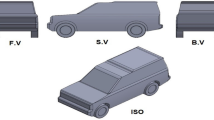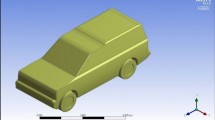Abstract
This paper details the computational design optimisation strategy employed to achieve an engineering solution to the problem of excessive supersonic lift at the rear of the BLOODHOUND SSC (SuperSonic Car) during its design. The optimisation problem is described first, followed by details of the computational fluid dynamics procedure employed to study the aerodynamic performance of the vehicle and the design optimisation strategy utilising Design of Experiments. The ‘optimised’ design resulting from this study is presented in the final section and contrasted with the ‘unoptimised’ baseline geometry. The final vehicle geometry presented in this paper is, at the time of writing, being built and is due to be tested in 2013 in an attempt to increase the World Land Speed Record from 763 mph to 1,000 mph.






















Similar content being viewed by others
References
Allright S (1990) Multiblock topology specification and grid generation for complete aircraft configurations. In: Applications of mesh generation to complex 3D configurations (conf proc no 464) (Paris: AGARD), pp 11.1–11.11
Arian E, Iolo A (2010) Challenges in aerodynamic optimization. In: Computational fluid dynamics review. World Scientific, Singapore, pp 447–467
Batten P, Clarke N, Lambert C, Causon DM (1997) On the choice of wavespeeds for the HLLC Riemann solver. SIAM J Sci Comput 18:1553–1570
Crumpton PI, Moinier P, Giles MB (1997) An unstructured algorithm for high Reynolds number flows on highly stretched grids. In: Taylor C, Cross JT (ed) Numerical methods in laminar and turbulent flow. Pineridge Press, Swansea, pp 561–572
Evans BJ et al (2011) Computational fluid dynamics applied to the aerodynamic design of a land–based supersonic vehicle. Numer Methods Partial Differ Equ 27:141–159 (MAFELAP 2009 Special Issue)
Harten A, Lax PD, Van Leer B (1983) On upstream differencing and Godunov–type schemes for hyperbolic conservation laws. SIAM Rev 25:35–61
Hassan O, Morgan K, Probert EJ, Peraire J (1996) Unstructured tetrahedral mesh generation for three–dimensional viscous flows. Int J Numer Methods Eng 39:549–567
Hocking RR (1976) The analysis and selection of variables in linear regression. Biometrics 32:1–49
Jameson A (1988) Aerodynamic design via control theory. ICASE report no 88–64. J Sci Comput 3:233–269
Jameson A, Vassberg JC (2001) Computational fluid dynamics: its current and future impact. AIAA Paper 2001-0538
Karypis G, Kumar V (1998) METIS4.0: unstructured graph partitioning and sparse and sparse matrix ordering system. Technical Report, Department of Computer Science, University of Minnesota
Lee D, Srivinas K, Gonzalez LF (2010) Robust multidisciplinary design optimisation using CFD and advanced evolutionary algorithms. In: Computational fluid dynamics review. World Scientific, pp 469–491
Morgan K, Peraire J (1998) Unstructured grid finite element methods for fluid mechanics. Rep Prog Phys 61:569–638
Morgan K, Hassan O, Weatherill NP (1999) Why didn’t the supersonic car fly? Math Today, Inst Math Appl 35:110
Noble R (1998) Thrust. Transworld, London
Nocedal J, Wright SJ (2006) Numerical optimization, 2nd edn. Springer Series in Operations Research, Springer
Peiró J, Peraire J, Morgan K (1989) The generation of triangular meshes on surfaces. In: Creasy C, Craggs C (eds) Applied surface modelling. Ellis–Horwood, Chichester, pp 25–33
Peiró J, Peraire J, Morgan K (1994) FELISA system reference manual. Part 1–basic theory. University of Wales Swansea Report C/R/821/94
Peraire J, Vahdati M, Morgan K, Zienkiewicz OC (1987) Adaptive remeshing for compressible flow simulations. J Comput Phys 72:449–466
Peraire J, Peiró J, Morgan K (1993) Multigrid solution of the 3D compressible Euler equations on unstructured tetrahedral grids. Int J Numer Methods Eng 36:1029–1044
Spalart PR, Allmaras SR (1992) A one–equation turbulent model for aerodynamic flows. AIAA Paper 92–0439
Sørensen KA (2002) A multigrid accelerated procedure for the solution of compressible fluid flows on unstructured hybrid meshes. PhD Thesis, University of Wales, Swansea
Sørensen KA, Hassan O, Morgan K, Weatherill NP (2003) A multigrid accelerated hybrid unstructured mesh method for 3D compressible turbulent flow. Comput Mech 31:101–114
Usab WJ, Murman EM (1985) Embedded mesh solutions of the Euler equations using a multiple–grid method. In: Habashi WG (ed) Advances in computational transonics. Pineridge Press, Swansea, pp 447–472
Weatherill NP, Forsey CR (1985) Grid generation and flow calculation for complex aircraft geometries using a multi–block scheme. AIAA Paper 85
Weatherill NP, Hassan O (1994) Efficient three–dimensional Delaunay triangulation with automatic boundary point creation and imposed boundary constraints. Int J Numer Methods Eng 37:2005–2039
White FM (2006) Viscous fluid flow, 3rd edn. McGraw Hill, Boston
Wilcox DC (1998) Turbulence modelling for CFD. DCW Industries Inc
The Story of ThrustSSC (1998) Corgi Books, London
Acknowledgments
The authors gratefully acknowledge the financial support provided for this work by the UK Engineering and Physical Sciences Research Council in the form of research grant EP/F032617. The work presented was a collaborative effort between Swansea University, BLOODHOUND Ltd and MathWorks with computational support provided by INTEL.
Author information
Authors and Affiliations
Corresponding author
Additional information
The authors gratefully acknowledge the financial support provided for this work by the UK Engineering and Physical Sciences Research Council in the form of research grant EP/F032617.
Rights and permissions
About this article
Cite this article
Evans, B., Morton, T., Sheridan, L. et al. Design optimisation using computational fluid dynamics applied to a land–based supersonic vehicle, the BLOODHOUND SSC. Struct Multidisc Optim 47, 301–316 (2013). https://doi.org/10.1007/s00158-012-0826-0
Received:
Revised:
Accepted:
Published:
Issue Date:
DOI: https://doi.org/10.1007/s00158-012-0826-0




